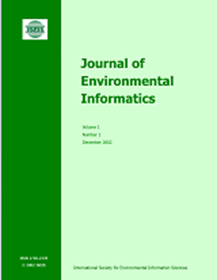两级多站点多变量天气发生器
IF 5.4
1区 环境科学与生态学
Q1 ENVIRONMENTAL SCIENCES
引用次数: 24
摘要
由天气发生器合成的气候变量空间结构对水文变率的模拟具有重要影响;然而,在大多数情况下,它需要大量的计算工作来重现多站点和/或多变量相关性。本工作提出了一个两阶段天气发生器(TSWG)来保存日降水、最高和最低温度的站点间和变量间相关性。第一阶段生成每个站点和每个变量的日降水量和温度,使用但不限于richardson型方法。第二阶段使用无分布洗牌过程重建多站点多变量相关性。TSWG应用于中国西北靖江流域的15个站点网络。它很好地再现了统计参数和多站点和多变量相关性。此外,水文模型的间接验证表明,TSWG输出可以令人满意地用于模拟径流变化。相关重建方法是一种无分布的方法,可以应用于具有不同概率分布的变量。TSWG可以对所有台站和所有变量进行一次优化,从而有效地重建相关性,这优于目前大多数对一个台站对和一个变量进行一次优化的方法。TSWG为改进多站点和多变量天气生成提供了一个选择。本文章由计算机程序翻译,如有差异,请以英文原文为准。
A Two-Stage Multisite and Multivariate Weather Generator
The spatial structure of climatic variables synthesized by a weather generator has considerable impact on the modeling of hydrological variability; however, in most cases, it needs computationally intensive work to reproduce multisite and/or multivariate correlations. This work proposed a two-stage weather generator (TSWG) to preserve intersite and intervariable correlations of daily precipitation, maximum and minimum temperatures. The first stage generates daily precipitation and temperature for each site and for each variable with, but not limited to, the Richardson-type approach. The second stage rebuilds the multisite multivariate correlation using a distribution-free shuffle procedure. The TSWG was applied to a network of 15 stations in the Jing River catchment (Northwest China). It reproduced the statistical parameters and multisite and multivariate correlations well. Furthermore, indirect validation by hydrological modeling showed TSWG outputs could be used satisfactorily for simulating streamflow variability. As a distribution-free method, the correlation reconstruction method can be applied to variables with different probability distributions. The TSWG can efficiently reconstruct the correlation with one optimization for all stations and all variables, which is superior to most current methods operated once for one station pair and one variable. The TSWG provides an option for improved multisite and multivariate weather generation.
求助全文
通过发布文献求助,成功后即可免费获取论文全文。
去求助
来源期刊

Journal of Environmental Informatics
ENVIRONMENTAL SCIENCES-
CiteScore
12.40
自引率
2.90%
发文量
7
审稿时长
24 months
期刊介绍:
Journal of Environmental Informatics (JEI) is an international, peer-reviewed, and interdisciplinary publication designed to foster research innovation and discovery on basic science and information technology for addressing various environmental problems. The journal aims to motivate and enhance the integration of science and technology to help develop sustainable solutions that are consensus-oriented, risk-informed, scientifically-based and cost-effective. JEI serves researchers, educators and practitioners who are interested in theoretical and/or applied aspects of environmental science, regardless of disciplinary boundaries. The topics addressed by the journal include:
- Planning of energy, environmental and ecological management systems
- Simulation, optimization and Environmental decision support
- Environmental geomatics - GIS, RS and other spatial information technologies
- Informatics for environmental chemistry and biochemistry
- Environmental applications of functional materials
- Environmental phenomena at atomic, molecular and macromolecular scales
- Modeling of chemical, biological and environmental processes
- Modeling of biotechnological systems for enhanced pollution mitigation
- Computer graphics and visualization for environmental decision support
- Artificial intelligence and expert systems for environmental applications
- Environmental statistics and risk analysis
- Climate modeling, downscaling, impact assessment, and adaptation planning
- Other areas of environmental systems science and information technology.
 求助内容:
求助内容: 应助结果提醒方式:
应助结果提醒方式:


